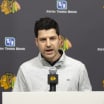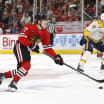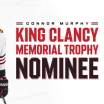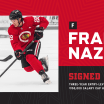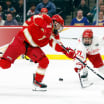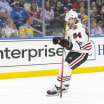This is the third piece of a three-part written obituary series by Team Historian Bob Verdi on Stan Mikita, who passed away on Tuesday, Aug. 7.
As a youngster on the 1961 championship team, Stan Mikita figured more Stanley Cups would follow. All the Blackhawks felt that way, but it wasn't to be. Despite some excellent regular seasons, the Blackhawks came up short in the playoffs - occasionally bedeviled by a hot goalie such as Terry Sawchuk of the Toronto Maple Leafs in 1967, the same year the Blackhawks overcame the "Curse of Muldoon" and finished atop the National Hockey League standings, a first for them.
Ten years after that fourth Cup, the Blackhawks were poised to claim their fifth. However, after winning the first two games of the 1971 Final, and holding a 2-0 lead in Game 7 at the Stadium, they bowed to the Montreal Canadiens, 3-2. That bitter defeat haunted Mikita.
Still, he continued to gather goals, assists and acclaim while leaving an imprint on the sport. Quite by accident during a scrimmage, Mikita discovered the wonders of a curved stick. Upon being checked into the boards, he found that his conventional straight stick blade jammed into the crack in the doorway that opened and closed by the players' bench. Mikita noticed that the blade had been bent slightly, but since it was late in practice, he saw no need to call downstairs for a replacement.
FEATURE: Remembering Mikita Part III - Forever a Blackhawk
Team Historian Bob Verdi writes about the late Stan Mikita in a three-part series
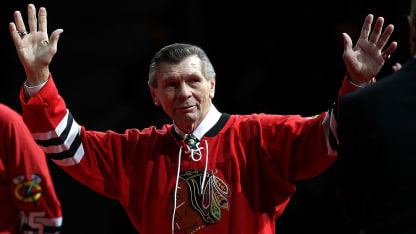
"Before I left the ice," he recounted, "I saw a puck just laying there and I took a shot with the curved blade that looked like a banana. I felt a different sensation. The puck not only sounded different, it acted different. I took a few more shots with a few more pucks. Same thing. Interesting."
Mikita, always thinking, tinkered with his other sticks, heating up the blades in boiling water or by using a blowtorch. Bobby Hull took note of the concept, as did goalie Glenn Hall, who hated practice even before being introduced to this fiery new weapon being wielded by his superstar teammates. Opposing netminders in actual games didn't appreciate the curved blade, either, and eventually the NHL instituted a rule restricting the extent to which a stick blade could be curved.
"Years later, Andy Bathgate of the New York Rangers said I stole his idea," Mikita recalled. "That was 1999, almost 20 years after I retired. But I never said I invented the curved stick. I never said I was Thomas Edison. I just stumbled onto it, and soon they were everywhere."
So were helmets. In 1967, against the Pittsburgh Penguins, a wayward puck tore off a piece of Mikita's right ear. Stitches ensued, and for the next game he wore a contraption featuring a cup from an athletic supporter attached to primitive headgear. Eventually, Mikita elected to wear a helmet fulltime, as had Red Berenson before him. Mikita designed one, tweaked it, and reasoned that he didn't have to worry about it inhibiting his good looks "because I didn't have any." As for the macho image it might tarnish, Mikita deduced that he'd long since solidified his manhood and had the scars to prove it.
"Pound for pound, the greatest hockey player ever," praised Hull. In 1979, the NHL made helmets mandatory.
Mikita and wife Jill raised four children (well, mostly Jill) - Meg, Scott, Jane and Christopher. The family lived here year-round, and became imbedded in the fabric of the community. Jill was a local lady who, upon being introduced to Stan, thought he was Dollard St. Laurent, a Blackhawk defenseman. When they married, Hall was Stan's best man and Mike Ditka was in the wedding.
Stan was a serial giver. At the behest of Irv Tiahnybik, a friend, Mikita became a prime mover in the American Hearing Impaired Hockey Association (AHIHA). Tiahnybik's son, Lex, loved hockey but assumed he couldn't play because he was deaf. Stan, as a celebrity driver, cancelled that notion for Lex and hundreds of other challenged youngsters. Stan identified with them, allowing that, "when I showed up in Canada at age 8, not knowing a word of English and what other kids were saying about me, I might as well have been deaf."
In 1987, along with Keith Magnuson and Jack Fitzsimmons, Mikita dove into another task - the formation of the Blackhawk Alumni. It has grown into a model organization among all professional sports. Cliff Koroll, whose first road roommate was Mikita, is president of the Alumni that has awarded more than $1 million in college scholarships. The group's largest fundraiser, an annual golf tournament, will be held later this month. The event still bears the name of Stan Mikita, now an absent comrade.
As Stan often remarked without rancor, he felt unwelcome around the Blackhawks after he retired. But that situation was rectified when Rocky Wirtz took over as chairman in the fall of 2007. He promptly hired as President & CEO John McDonough, a decorated baseball executive who inherited an utterly dysfunctional franchise. McDonough's slate of problems to be fixed could have choked a horse, but his to-do shortlist addressed the issue of fractured relationships in desperate need of repair.
"John was aware of how Bobby and I had left the Blackhawks in kind of a bad way and asked if I would be interested in becoming one of the team's Ambassadors," Mikita wrote in his "Forever A Blackhawk" autobiography. "Would I like to be part of the organization again? Would I like to be part of the Blackhawk family again? At first I thought it was a prank. Maybe one of my buddies had too many beers. John told me to think about it. I hung up the phone and looked at Jill. I asked her to pinch me. Was this really happening? I'd been waiting 30 years for this call."
Shortly thereafter, Mikita and Hull were announced as Ambassadors at a United Center love-in. Welcome back. Then, for the sake of posterity as the 2011-12 season commenced, statues of Mikita and Hull were unveiled beside the United Center.
Monuments to Excellence.
"I thought for sure that I would be forgotten," rasped Mikita as he gazed at his bronzed likeness. "Instead, I am still being remembered. How lucky can a guy be?"
And how lucky are we all to have known Stan Mikita.


